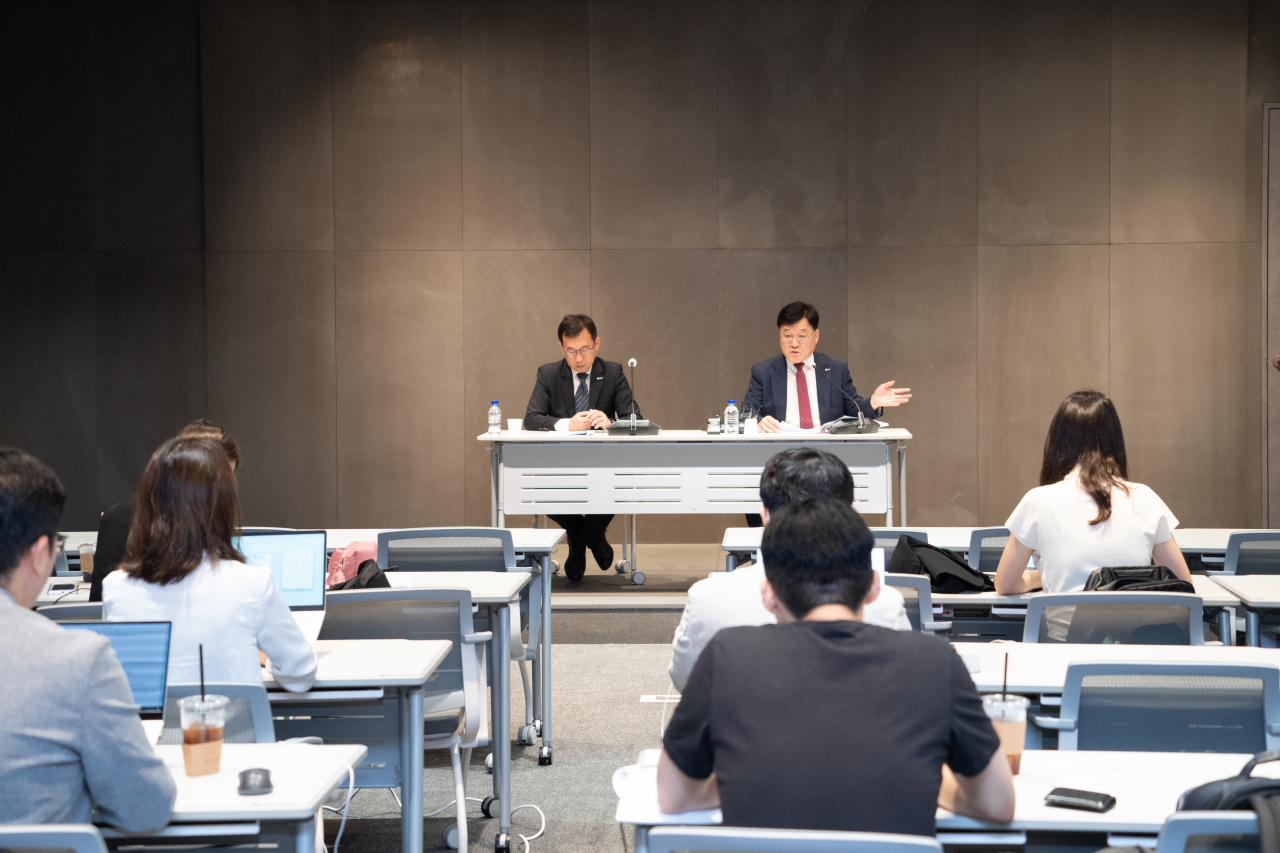 |
Jeong Marn-ki, vice chairman of the Korea International Trade Association, speaks at a press conference at the KITA headquarters in southern Seoul’s Samseong-dong on Wednesday. (KITA) |
South Korea's trade deficit will persist in the second half of this year, following the same pattern observed in the first half, according to a Korean trade lobby group on Wednesday.
Nevertheless, there is anticipation for a gradual recovery resembling a "U-shape" in the long term, as the trade deficits continue to decrease steadily.
“It is difficult to anticipate a V-shaped recovery. Although we are uncertain about the duration, we expect to see a U-shaped recovery,” Cho Sang-hyun, head of the Korea International Trade Association 's Institute for International Trade, said during a press conference at the KITA headquarters in southern Seoul’s Samseong-dong on Wednesday.
Jeong Marn-ki, vice chairman of KITA, added that while there may be a few events that could potentially lead to a V-shaped recovery, such as a sudden end of the war between Russia and Ukraine as well as the US' decision to lower interest rates.
"They could boost the global economy, but both of them are unlikely to happen soon,” Jeong added.
KITA forecasts that in the second half of the year exports will decrease by 3.1 percent on-year to $322.7 billion, while imports will drop by 12.4 percent on-year to $323.9 billion. A trade deficit of $1.2 billion is anticipated.
In particular, semiconductor exports are anticipated to improve due to a recovery in demand, possibly starting from the fourth quarter.
On the other hand, automobile exports are expected to weaken in the second half of the year due to a global decrease in demand.
In terms of the annual outlook, this year's exports were projected to decrease by 7.7 percent from the previous year to $630.9 billion, while imports are expected to decrease by 9.7 percent to $660.5 billion. A trade deficit of about $29.5 billion is anticipated.
There has also been gradual improvement in the trade deficit, with monthly deficits recording $12.5 billion in January, $5.3 billion in February, $4.7 billion in March, $2.6 billion in April and $2.1 billion in May.
At the conference, KITA officials also summed up trade outcomes for the first half of this year.
During the first half, trade volume amounted to $601 billion, which was a decrease of 8.7 percent compared to the same period last year.
Exports decreased by 11.8 percent to $286 billion, while imports decreased by 7.4 percent to $315 billion. The trade deficit stood at $29 billion.
KITA attributed the lackluster performance of trade in the first half to several factors, including a global economic slowdown due to rising interest rates, a decline in IT exports and dependence on China for imports.
KITA’s data for the January-May period also showed that the share of intermediate goods in total exports fell below 70 percent for the first time since 2017.
When looking into the trade data for the first five months classified by different regions, exports to major overseas production bases China and Vietnam dropped by 27.4 percent and 24 percent, respectively.
During the first five months, the trade deficit with China reached $11.8 billion, signifying its noteworthy shift from being the leading trade surplus country to the leading trade deficit country.
“The good news is exports during the first 20 days of June showed an increase of 5.3 percent compared to the same period last year, marking the first growth in 10 months,” Jeong said.
It is estimated that this increase in exports was partially influenced by the usual rise in export activity that happens toward the end of the first half of the year, Jeong explained.
Meanwhile, Finance Minister Choo Kyung-ho reiterated his expectations for an economic recovery in the second half of this year on Wednesday morning.
However, he added that uncertainties persist in various aspects of the Korean economy.
“Among others, Korea will focus on revitalizing the economy, including promoting exports and investment, along with fostering the domestic market and provincial economies," the finance minister said ahead of a closed-door meeting with economy-related ministers in Seoul on Wednesday.







![[Today’s K-pop] Blackpink’s Jennie, Lisa invited to Coachella as solo acts](http://res.heraldm.com/phpwas/restmb_idxmake.php?idx=644&simg=/content/image/2024/11/21/20241121050099_0.jpg)